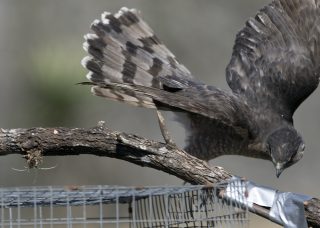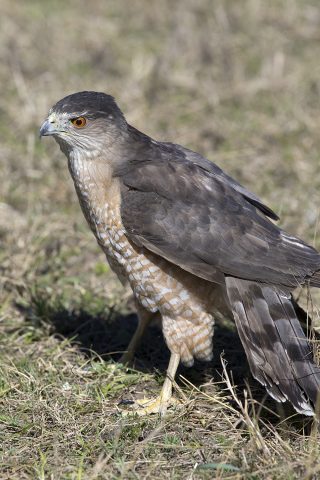
This large female Cooper’s Hawk was so hungry she was trying to reach through the bars of a wire cage to grab a pigeon. Cooper’s Hawks are birds-of-prey that typically hunt smaller birds for food. Robert Benson photo.
02/03/2017 – Our Birds Love a Buffet!
In order to attract a diverse group of species to our feeders we have been offering a variety of foods. Seeds, of course, are the main thing. We put out black-oil sunflower seeds in great quantities. These small sunflower seeds are rich in protein and fats, and the birds love them. We see cardinals, titmice, finches, blackbirds, woodpeckers and orioles feasting on the tasty seeds all day long. Since the black-oil sunflower seeds are still in their shells, it takes the birds a minute or so to strip the hull from the kernel, extending our watching time.
To tempt the Green Jays, we put out whole peanuts. Peanuts are also a favorite with titmice, who carry the whole pod to a branch to break it open. They stabilize the peanut with their feet while pecking the shell off the nuts. Sometimes a three-or-four-kernel peanut is larger than the titmouse carrying it away! These little guys are fun to watch as they balance on the peanut and struggle to open it.
Not all bird species are seed-eaters. Many birds are at least part-time insectivores. For warblers, wrens, woodpeckers, and orioles we keep at least one or two suet feeders filled at all times. The Orange-crowned Warblers and Bewick’s Wrens pick out bits of fat from the suet cake. Suet cakes usually have seeds and nuts embedded in the fat, too. Woodpeckers and Audubon’s Orioles seem to prefer extracting the fat-covered seeds from the suet. I think it must be kind of like “milk and cereal” to them.

Cooper’s Hawks, like their close relatives Sharp-shinned Hawks, are lanky birds with short wings and long tails. They are agile hunters, flying through the branches of trees to capture unsuspecting birds for their dinner. Robert Benson photo.
Some insectivores only want the real deal: insects. Occasionally you can find insect-based suet cakes. Lacking those, a tray of freeze-dried mealworms will attract bluebirds, and maybe a wren or two. Live mealworms, which are the larvae of a darkling beetle, can be raised on oats or bran with a halved-apple for moisture. The inch-long brown larvae are best served up a few at a time in a small bowl at your feeder station.
Since sparrows and doves like smaller seeds, the best food is a mix of millet and milo. These birds like to feed on the ground, but you can encourage them to come up to a platform feeder. Some food may fall off the platform, but don’t worry. Doves, sparrows, and even bobwhites will readily scavenge any spilled seeds.
House Sparrows, do you really want them at your feeder? Some people don’t, but it is hard to exclude them. House Sparrows, in large numbers, can gobble down a lot of food. And, they are pretty happy to eat most anything from suet to seeds.
Don’t forget the fruit and nectar-eaters! Halved oranges nailed to a branch, and sugar water in nectar feeders will bring in summering orioles, woodpeckers, and of course, hummingbirds. Kiskadees have been seen sipping nectar, too.
A full buffet attracts many birds, including species that come to dine on the buffet-goers themselves! This may come as a shock to birdwatchers . Their gorgeous cardinals and feisty little sparrows can suddenly become the hawk’s dinner.
Not all species of hawks are bird-hunters. Red-tailed Hawks mostly go for mice and voles, Red-shouldered Hawks are fond of frogs, Harris’ Hawks frequently take reptiles. However, the Accipiters, one genus of hawks, are bird-hawks.
There are three species of Accipiters in North America. The large, forest-dwelling, Goshawk’s range does not include Texas, but the Cooper’s Hawk and smaller Sharp-shinned Hawk occur here. Accipiters have short wings and long tails, in general, giving them a rather lanky appearance. Their shape helps them negotiate between tree branches and make sharp turns to catch avian prey.
Cooper’s Hawks and Sharp-shinned Hawks look very much alike. The two even overlap in size. Female Accipiters are larger than the males (this is a characteristic of many birds of prey.) A female Sharp-shinned can be the same size as a male Cooper’s Hawk. Their plumage is almost identical. This makes identification tricky. Sometimes, the best you can do to identify one of these hawks is to say it is a small Cooper’s or a large Sharp-shinned!
This was not the case earlier this week. My husband raced in saying that a large female Cooper’s was sitting on his pigeon loft. He grabbed his camera and urged me to drop what I was doing to come and look at the hawk. I did. It was a beautiful big bird, most assuredly a female by her size, and she acted quite tame. Actually, I think she was quite hungry. She refused to leave the roof of the loft. Robert retrieved a couple of pigeons and placed them in a wire cage out where she could see them. He leaned a huisache branch across the cage and then stepped back a few paces to photograph the hawk.
In moments, she was on the cage, eyeing the pigeons within. She cocked her head and reached a long, slender yellow leg in between the bars. She jumped about anticipating a plump pigeon meal. Robert got great photos, some from so close he could have touched her. Her red eyes glowed with a feverish hunger. She slid a leg between the wires again and this time grabbed one of the pigeons by its head! It pulled away from the hawk’s talons, uninjured. I was concerned that she would break one of her delicate-looking legs in the cage wires, if she tried to reach a pigeon again. Robert was concerned that the hawk was exhausting herself. He returned the pigeons to the breeders’ loft. However, the desperately hungry Cooper’s Hawk only moved a few feet away.
We were worried about the hawk. We needed to offer her something from the buffet. Seeds wouldn’t do. It had to be a bird. I convinced my husband to give the hawk one of his older pigeons, one that was destined to be a “lure” bird in his practice of falconry. I may have promised not to tell. (Oops.)
Robert caught up one of his expendable pigeons and tossed it out in front of the waiting raptor. The pigeon fluttered to the ground. The Cooper’s Hawk watched it “like a hawk” and in seconds dropped down from the tree. It dispatched the pigeon and began to pluck it. The hungry hawk wasted little time before it began to feast on its prey.
We may have lost a pigeon, but we had an incredible view of a wild hawk making a meal. All things feed on something else. It is Nature’s way. We just helped replenish the buffet.
If you would like to offer comments, please click through to the discussion page
